Clinical experience with methylprednisolone aceponate for atopic dermatitis in young children
- Авторлар: Botkina A.S.1, Gumennaia E.R.2
-
Мекемелер:
- Pirogov Russian National Research Medical University
- Russian Children’s Clinical Hospital – Branch of Pirogov Russian National Research Medical University
- Шығарылым: Том 32, № 7 (2025)
- Беттер: 106-114
- Бөлім: Clinical experience
- URL: https://journals.eco-vector.com/2073-4034/article/view/693744
- DOI: https://doi.org/10.18565/pharmateca.2025.7.106-114
- ID: 693744
Дәйексөз келтіру
Аннотация
Atopic dermatitis, or atopic eczema, is a chronic, relapsing inflammatory skin disease characterized by generalized xerosis, erythematous rash, and intense pruritus. Clinical manifestations vary and depend on the patient’s age. As one of the most common skin diseases worldwide, atopic dermatitis represents a significant clinical and economic burden for patients and their families. Infants present particular challenges in treatment due to the anatomical and physiological characteristics of their skin and the limited range of approved topical anti-inflammatory agents. This article highlights the key aspects of topical corticosteroid use in pediatric dermatology. A clinical example of the effective use of methylprednisolone aceponate in the treatment of infantile atopic dermatitis is presented. Timely and appropriate administration of topical corticosteroids allows for rapid interruption of exacerbations of the skin condition without the development of adverse side effects.
Негізгі сөздер
Толық мәтін
Авторлар туралы
Aleksandra Botkina
Pirogov Russian National Research Medical University
Email: botkina@gmail.com
ORCID iD: 0000-0001-6890-2041
Cand. Sci. (Med.), Associate Professor, Department of Hospital Pediatrics named after Academician V.A. Tabolin, Faculty of Pediatrics
Ресей, MoscowElvira Gumennaia
Russian Children’s Clinical Hospital – Branch of Pirogov Russian National Research Medical University
Хат алмасуға жауапты Автор.
Email: botkina@gmail.com
ORCID iD: 0000-0002-8097-2816
Dermatovenerologist, Head of the Dermatovenereology Department
Ресей, MoscowӘдебиет тізімі
- Европейское руководство по лечению дерматологический заболеваний. Под редакцией Кацамбаса А.Д., Лотти Т.М. 2009. М.: «МЕДпресс-информ», 724 с. [European guidelines for the treatment of dermatological diseases. Edited by Katsambas A.D., Lotti T.M. 2009. Moscow: MEDpress-inform, 724 p. (In Russ.)]
- Williams H.C. Clinical practice. Atopic dermatitis. N Engl J Med. 2005;352(22):2314–2324. https://dx.doi.org/10.1056/NEJMcp042803
- Eichenfield L.F., Tom W.L., Chamlin S.L., et al. Guidelines of care for the management of atopic dermatitis: section 1. Diagnosis and assessment of atopic dermatitis. J Am Acad Dermatol. 2014;70(2):338–351. https://dx.doi.org/10.1016/j.jaad.2013.10.010
- Udkoff J., Borok J., Vaida F., et al. Assessment of the American Academy of Dermatology diagnostic criteria for pediatric atopic dermatitis and modification into a checkbox form: a cross-sectional study. Pediatr Dermatol. 2023;40(5):809–815. https://dx.doi.org/10.1111/pde.15338
- Jeskey J., Kurien C., Blunk H., et al. Atopic dermatitis: a review of diagnosis and treatment. J Pediatr Pharmacol Ther. 2024;29(6):587–603. https://dx.doi.org/10.5863/1551-6776-29.6.587
- Chu D.K., Schneider L., Asiniwasis R.N., et al. Atopic dermatitis (eczema) guidelines: 2023 American Academy of Allergy, Asthma and Immunology/American College of Allergy, Asthma and Immunology Joint Task Force on practice parameters GRADE- and institute of medicine-based recommendations. Ann Allergy Asthma Immunol. 2024;132(3):274–312. doi: 10.1016/ j.anai.2023.11.009
- Boguniewicz M., Fonacier L., Guttman-Yassky E., et al. Atopic dermatitis yardstick: practical recommendations for an evolving therapeutic landscape. Ann Allergy Asthma Immunol. 2018;120(1):10–22. https://dx.doi.org/10.1016/j.anai.2017.10.039
- Tang T.S., Bieber T., Williams H.C. Are the concepts of induction of remission and treatment of subclinical inflammation in atopic dermatitis clinically useful. J Allergy Clin Immunol. 2014;133(6):1615–1625. https://dx.doi.org/10.1016/j.jaci.2013.12.1079
- Sidbury R., Alikhan A., Bercovitch L., et al. Guidelines of care for the management of atopic dermatitis in adults with topical therapies. J Am Acad Dermatol. 2023;89(1):e1–e20. https://dx.doi.org/doi: 10.1016/j.jaad.2022.12.029
- Chu D.K., Chu A.W.L., Rayner D.G., et al. Topical treatments for atopic dermatitis (eczema): systematic review and network meta-analysis of randomized trials. J Allergy Clin Immunol. 2023;152(6):1493–1519. https://dx.doi.org/10.1016/j.jaci.2023.08.030
- Niedner R. Therapie mit systemischen glukokortikoiden [Therapy with systemic glucocorticoids]. Hautarzt. 2001;52(11):1062–1071. https://dx.doi.org/10.1007/pl00002604
- Galli E., Neri I., Ricci G., et al. Consensus conference on clinical management of pediatric atopic dermatitis. Ital J Pediatr. 2016;42:26. https://dx.doi.org/10.1186/s13052-016-0229-8
- Wollenberg A., Kinberger M., Arents B., et al. European guideline (EuroGuiDerm) on atopic eczema – part II: non-systemic treatments and treatment recommendations for special AE patient populations. J Eur Acad Dermatol Venereol, 2022;36:1904–1926. https://doi.org/10.1111/jdv.18429
- Stacey S.K., McEleney M. Topical corticosteroids: choice and application. Am Fam Physician. 2021;103(6):337–343.
- Lax S.J., Harvey J., Axon E., et al. Strategies for using topical corticosteroids in children and adults with eczema. Cochrane Database Syst Rev. 2022;3(3):CD013356. doi: 10.1002/14651858.CD013356.pub2
- Torrelo A. Methylprednisolone aceponate for atopic dermatitis. Int J Dermatol. 2017;56(6):691–697. https://dx.doi.org/10.1111/ijd.13485
- Волкова Е.Н., Ланге Д.А., Родина Ю.А., Тарасова М.В. Метилпреднизолона ацепонат в комплексной терапии хронических дерматозов: анализ тактических ошибок применения. Клиническая дерматология и венерология. 2010;8(5):97–102. [Volkova E.N., Lange D.A., Rodina Yu.A., Tarasova M.V. Methylprednisolone aceponate in the complex therapy of chronic dermatoses: analysis of tactical errors of use. Clinical dermatology and venereology. 2010;8(5):97–102. (In Russ.)]
- Contento M., Cline A., Russo M. Steroid phobia: a review of prevalence, risk factors, and interventions. Am J Clin Dermatol. 2021;22(6):837–851. https://dx.doi.org/10.1007/s40257-021-00623-6
Қосымша файлдар


















